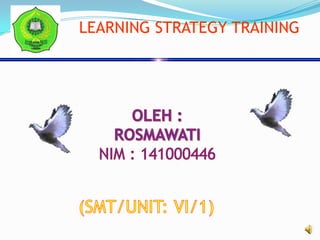Tugas aplikom
- 2. 1975, Rubin: good language learners facilitate their learning. Good language learners: - willing and accurate guessers who have a strong desire to communicate, even appear fool. -attend to both meaning and form of their message. -practice and monitor their own speech as well as others.
- 3. Background (cont.) In order to maximise (good) language learners potential and contribute to their autonomy, they need training in learning strategies. Learning strategy training: training students in the use of learning strategies in order to improve their learning effectiveness
- 4. Example in the textbook (Larsen- Freeman, D.,2000,p.160) 1.T reads Ssâ learning journals- finds Ssâ learning problems. 2. T decides to have Ss to work on the strategy of advance organisation. 3.T models the use of the strategy
- 5. : Example in the textbook (Larsen-Freeman, D.,2000,p.160) 4. Ss practice the new learning strategy (âhand-onâ experience). 5. Ss evaluate their own success in learning the strategy and modify it to meet their own learning needs (self-regulated, self-assessment).
- 6. Principles Teacherâs job is not only to teach lang. but learning. Strategies should not be taught in isolation, but rather as part of the content-area or language curriculum. Help learners to continue to learn after completing formal study of the target language.
- 7. Meta cognitive strategies Use to plan, monitor and evaluate a learning task. Arrange the conditions that help one to learn. Set long and short-term goals. Check Ssâ comprehension during listening or reading.
- 8. Cognitive Strategies Learners interact and manipulate what is to be learned. e.g.: replaying a word or phrase mentally to âlistenâ to it again. learn a new word by associating with a familiar word by creating a visual image.
- 9. Biografi Penulis Nama:Rosmawati, Lahir di Birem Rayeuk pada tanggal 29-07-1992 Alamat: Kp.Birem Rayeuk kec.Birem Bayeun Kab.Aceh Timur. Hp: 082364135258 gmail: rosrosmawati92@gmail.com Studi: SI jurusan Tarbiyah , Prodi: PBI NIM : 141000446
- 10. TERIMA KASIH ATAS PERHATIAN MOHON MAAF ATAS SEMUA KEKURANGAN










